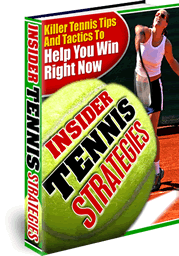
Listen to what Janko Tipsarevic said after losing a classic tennis match to Roger Federer the other night -- "I couldn't read his serve".
In all of tennis instruction, shot disguise is the least discussed part of tennis technique.
What is disguise as it applies to tennis shots?
Basically, a shot is well disguised if the receiver doesn't pick up any cues early on that will tip the receiver as to where the ball is going.
Cues that tip off the direction of the shot include the setup of the feet, the position of the shoulders, the timing of the rotation, and different locations for the service toss.
The great servers toss the ball in the same location for all the different serves. Less skillful servers tip off what type of serve is going to be hit by the toss. The toss may be to the left and over the head for a kick serve, to the right for a slice serve, and in betweeen for a flat serve.
There's a story floating around as to how Pete Sampras used to practice as he was developing his serve.
Pete would toss the ball to the same location each time without knowing where he was going to hit the ball. At the last second, his coach would yell out where the serve was supposed to go and Pete would make a last millisecond adjustment of his hand to change the direction of the ball.
From a returner's point of view, it is very frustrating to play a player with great disguise on the serve. You have to wait until after the ball is hit to know where it's going and that's usually too late if the serve is well placed.
That's probably why Andy Rodick's serve at 140 mph seems to be less effective than Federer's serve at 120. Roddick probably cues the direction where Federer doesn't.
As you try to work on your game try to swing the same way for different shots and change the direction of the ball by slighty varying the contact point.
Ask your practice partners if they can tell where your shots are going and when they can tell. If your partners can read where your shots are going before the ball is actually hit, then you are probably giving something away.
So, the moral of the story is to keep working on that disguise.
Until next time,
Glenn Sheiner M.D. - author of Insider Tennis Strategies Insider Tennis Tactics To Win More Matches guaranteed to make you a smarter tennis player and take your tennis to the next level. Also, check out the world's top tennis humor screensaver
Tennis Cartoon Screensaver. You can download a trial version for FREE.
Technorati Tags Tennis